Doppler and Channel Estimation Using Superimposed Linear Frequency Modulation Preamble Signal for Underwater Acoustic Communication
Abstract
1. Introduction
- 1.
- To achieve Doppler and channel estimation using the preamble signal, a preamble signal based on the superimposed LFMs is designed. Specifically, the designed preamble signal is composed of an up-sweeping LFM signal and a down-sweeping LFM signal, which are superimposed in the time domain. Differing from the traditional frame structure that inserts two identical LFM signals before and after the data block, the designed preamble signal can achieve real-time estimation. Compared with the preamble signal using HFM signals, the designed preamble signal is easy to generate and does not increase the time duration.
- 2.
- As revealed in [14], under the influence of the Doppler factor, the LFM signal has an approximate linear relationship between the correlation peak shift and the Doppler factor. Hence, a Doppler estimation method is proposed utilizing the relationship between the relative correlation peak shift of two superimposed LFM signals and the Doppler factor. Moreover, once the Doppler factor is estimated, the timing synchronization can be realized simultaneously.
- 3.
- An improved OMP channel estimation algorithm utilizing the designed preamble signal is proposed. Since the preamble signal is composed of two LFM signals, it also has excellent autocorrelation characteristics. In the proposed algorithm, the received preamble signal (after Doppler compensation) is correlated with the local reference signal, and the correlation peaks occur at the positions corresponding to the multipath delay. According to the position of these correlation peaks, the sparsity and multipath delays can be determined initially, and the multipath delays can be used to simplify the dictionary matrix of the OMP algorithm. Hence, compared with the OMP algorithm, the proposed algorithm not only solves the problem of the iteration termination condition, but also has a lower computational complexity.
- 4.
- The simulated and experimental results demonstrate that using the designed preamble signal, the proposed algorithms can estimate Doppler and channel state information effectively and improves the performance of the UWA communication system.
2. System Model and Problem Statement
2.1. System Model
2.2. Problem Statement
3. Proposed Methods
3.1. Superimposed-LFM-Based Preamble Signal
3.2. The Real-Time Doppler Estimation Algorithm
3.3. The Enhanced OMP Channel Estimation Algorithm
| Algorithm 1: CPS-IOMP algorithm |
| Input: dictionary matrix, A; received preamble signal after Doppler compensation, ; threshold η. Initialization: residual vector, = ; support set, = Ø. 1: Perform the correlation processing between the received preamble signal after Doppler compensation and the locally generated preamble signal. 2: Search for the correlation peaks with normalized amplitude larger than threshold η. 3: Estimate the channel sparsity k and construct the simplified dictionary matrix . 4: for s = 1 to k do 5: Perform (24); 6: Perform (25); 7: Perform (26); 8: Perform (27); 9: end for Output: . |
4. Numerical Results and Discussions
4.1. Simulation Results
4.2. Sea Trial Data Analysis Results
5. Conclusions
Author Contributions
Funding
Institutional Review Board Statement
Informed Consent Statement
Data Availability Statement
Conflicts of Interest
References
- Kilfoyle, D.B.; Baggeroer, A.B. The state of the art in underwater acoustic telemetry. IEEE J. Oceanic Eng. 2000, 25, 4–27. [Google Scholar] [CrossRef]
- Stojanovic, M.; Catipovic, J.A.; Proakis, J.G. Phase-coherent digital communications for underwater acoustic channels. IEEE J. Oceanic Eng. 1994, 19, 100–111. [Google Scholar] [CrossRef]
- Li, B.; Tong, F.; Li, J.-H.; Zheng, S.-Y. Cross-correlation quasi-gradient Doppler estimation for underwater acoustic OFDM mobile communications. Appl. Acoust. 2022, 190, 108640. [Google Scholar] [CrossRef]
- Johnson, M.; Freitag, L.; Stojanovic, M. Improved Doppler tracking and correction for underwater acoustic communications. In Proceedings of the 1997 IEEE International Conference on Acoustics, Speech, and Signal Processing, Munich, Germany, 21–24 April 1997; pp. 575–578. [Google Scholar]
- Sharif, B.S.; Neasham, J.; Hinton, O.R.; Adams, A.E. A computationally efficient Doppler compensation system for underwater acoustic communications. IEEE J. Oceanic Eng. 2000, 25, 52–61. [Google Scholar] [CrossRef]
- Lin, W.; Zhang, X.; Huang, J. Doppler processing method in multicarrier coherent underwater acoustic communication. J. Northwest. Polytech. Univ. 2005, 23, 520–524. [Google Scholar]
- Zhang, X. Simulation research on Doppler frequency shift compensation in underwater acoustic communication. J. Syst. Simul. 2005, 17, 1172–1174. [Google Scholar]
- Huang, J.; Guo, S.; Guo, Z.; Chen, G. Doppler compensation for underwater acoustic broadband signal. Tech. Acoust. 2009, 28, 99–103. [Google Scholar]
- He, C.; Huang, J.; Meng, J.; Zhang, Q. Accurate Doppler factor estimation for multipath underwater acoustic channels. Audio Eng. 2010, 34, 57–59. [Google Scholar]
- Trubuil, J.; Chonavel, T. Accurate Doppler estimation for underwater acoustic communications. In Proceedings of the 2012 Oceans—Yeosu, Yeosu, Republic of Korea, 21–24 May 2012; pp. 1–5. [Google Scholar]
- Zheng, S.; Tong, F.; Li, B.; Tao, Q.; Song, A.; Zhang, F. Design and evaluation of an acoustic modem for a small autonomous unmanned vehicle. Sensors 2019, 19, 2923. [Google Scholar] [CrossRef] [PubMed]
- Samir, A.; Eldiwany, B.; ElMoslimany, A.; Nafie, M.; El-Sherif, A.A.; ElBatt, T. On the Design of a High Data Rate Underwater Acoustic Receiver. In Proceedings of the 2022 5th International Conference on Communications, Signal Processing, and their Applications, Cairo, Egypt, 27–29 December 2022; pp. 1–7. [Google Scholar]
- Zhang, X.; Kong, F.; Feng, H. Frequency offset estimation and synchronization of underwater acoustic communication using hyperbolic frequency modulation signal. Tech. Acoust. 2010, 29, 210–213. [Google Scholar]
- Wang, K.; Chen, S.; Liu, C.; Liu, Y.; Xu, Y. Doppler estimation and timing synchronization of underwater acoustic communication based on hyperbolic frequency modulation signal. In Proceedings of the 2015 IEEE 12th International Conference on Net-working, Sensing and Control, Taipei, Taiwan, 9–11 April 2015; pp. 75–80. [Google Scholar]
- Zhao, S.; Yan, S.; Xu, L. Doppler estimation based on HFM signal for underwater acoustic time-varying multipath channel. In Proceedings of the 2019 IEEE International Conference on Signal Processing, Communications and Computing, Dalian, China, 20–22 September 2019; pp. 1–6. [Google Scholar]
- Xin, M.; Li, W.; Wang, X.; Zhang, Y.; Xu, L. Preamble design with HFMs for underwater acoustic communications. In Proceedings of the 2018 MTS/IEEE OCEANS—Kobe, Kobe, Japan, 28–31 May 2018; pp. 1–5. [Google Scholar]
- Wei, R.; Li, X.; Fu, Y.; Ma, X. Performance analysis on the speed spectrum estimation based on dual-HFM waveform. EURASIP J. Adv. Signal Process. 2022, 2022, 125. [Google Scholar] [CrossRef]
- Dubey, N.; Pandit, A. A comprehensive review on channel estimation in OFDM system. Int. J. Online Sci. 2019, 5, 1–6. [Google Scholar] [CrossRef][Green Version]
- Gong, G.; Yao, W. Adaptive estimation of sparse channel based on modified RLS for coherent underwater acoustics communications. Appl. Acoust. 2022, 192, 108745. [Google Scholar] [CrossRef]
- Berger, C.R.; Zhou, S.; Preisig, J.C.; Willett, P. Sparse channel estimation for multicarrier underwater acoustic communication: From subspace methods to compressed sensing. IEEE Trans. Signal Process. 2010, 58, 1708–1721. [Google Scholar] [CrossRef]
- Pati, Y.C.; Rezaiifar, R.; Krishnaprasad, P.S. Orthogonal matching pursuit: Recursive function approximation with applications to wavelet decomposition. In Proceedings of the IEEE 27th Asilomar Conference on Signals, Systems and Computers, Pacific Grove, CA, USA, 1–3 November 1993; pp. 40–44. [Google Scholar]
- Jiang, W.; Tong, F.; Zhu, Z. Exploiting rapidly time-varying sparsity for underwater acoustic communication. IEEE Trans. Veh. Technol. 2022, 71, 9721–9734. [Google Scholar] [CrossRef]
- Wang, Z.; Li, Y.; Wang, D.; Ouyang, D.; Huang, Y. A-OMP: An Adaptive OMP Algorithm for Underwater Acoustic OFDM Channel Estimation. IEEE Wirel. Commun. Lett. 2021, 10, 1761–1765. [Google Scholar] [CrossRef]
- Jia, S.; Zou, S.; Zhang, X.; Tian, D.; Da, L. Multi-block sparse Bayesian learning channel estimation for OFDM underwater acoustic communication based on fractional Fourier transform. Appl. Acoust. 2022, 192, 108721. [Google Scholar] [CrossRef]
- Jia, S.; Zou, S.; Zhang, X.; Da, L. Underwater acoustic channel estimation based on sparse Bayesian learning algorithm. IEEE Access 2023, 11, 7829–7836. [Google Scholar] [CrossRef]
- Preisig, J.C.; Deane, G.B. Surface wave focusing and acoustic communications in the surf zone. J. Acoust. Soc. Am. 2004, 116, 2067–2080. [Google Scholar] [CrossRef]
- Siderius, M.; Porter, M.B.; Hursky, P.; McDonald, V. Modeling Doppler effects for acoustic communications. J. Acoust. Soc. Am. 2006, 119, 3397. [Google Scholar] [CrossRef]
- Mason, S.F.; Berger, C.R.; Zhou, S.; Willett, P. Detection, synchronization, and Doppler scale estimation with multicarrier waveforms in underwater acoustic communication. IEEE J. Sel. Areas Commun. 2008, 26, 1638–1649. [Google Scholar] [CrossRef]
- Tufts, D.W.; Ge, H.; Umesh, S. Fast maximum likelihood estimation of signal parameters using the shape of the compressed likelihood function. IEEE J. Oceanic Eng. 1993, 18, 388–400. [Google Scholar] [CrossRef]
- Cook, C.E.; Bernfeld, M. Radar Signals: An Introduction to Theory and Application; Academic Press Inc: New York, NY, USA, 1967. [Google Scholar]
- Bajwa, W.U.; Haupt, J.D.; Raz, G.M.; Wright, S.J.; Nowak, R.D. Toeplitz-structured compressed sensing matrices. In Proceedings of the 2007 IEEE/SP 14th Workshop on Statistical Signal Processing, Madison, WI, USA, 26–29 August 2007; pp. 294–298. [Google Scholar]
- Yang, T.-C. Properties of underwater acoustic communication channels in shallow water. J. Acoust. Soc. Am. 2012, 131, 129–145. [Google Scholar] [CrossRef] [PubMed]
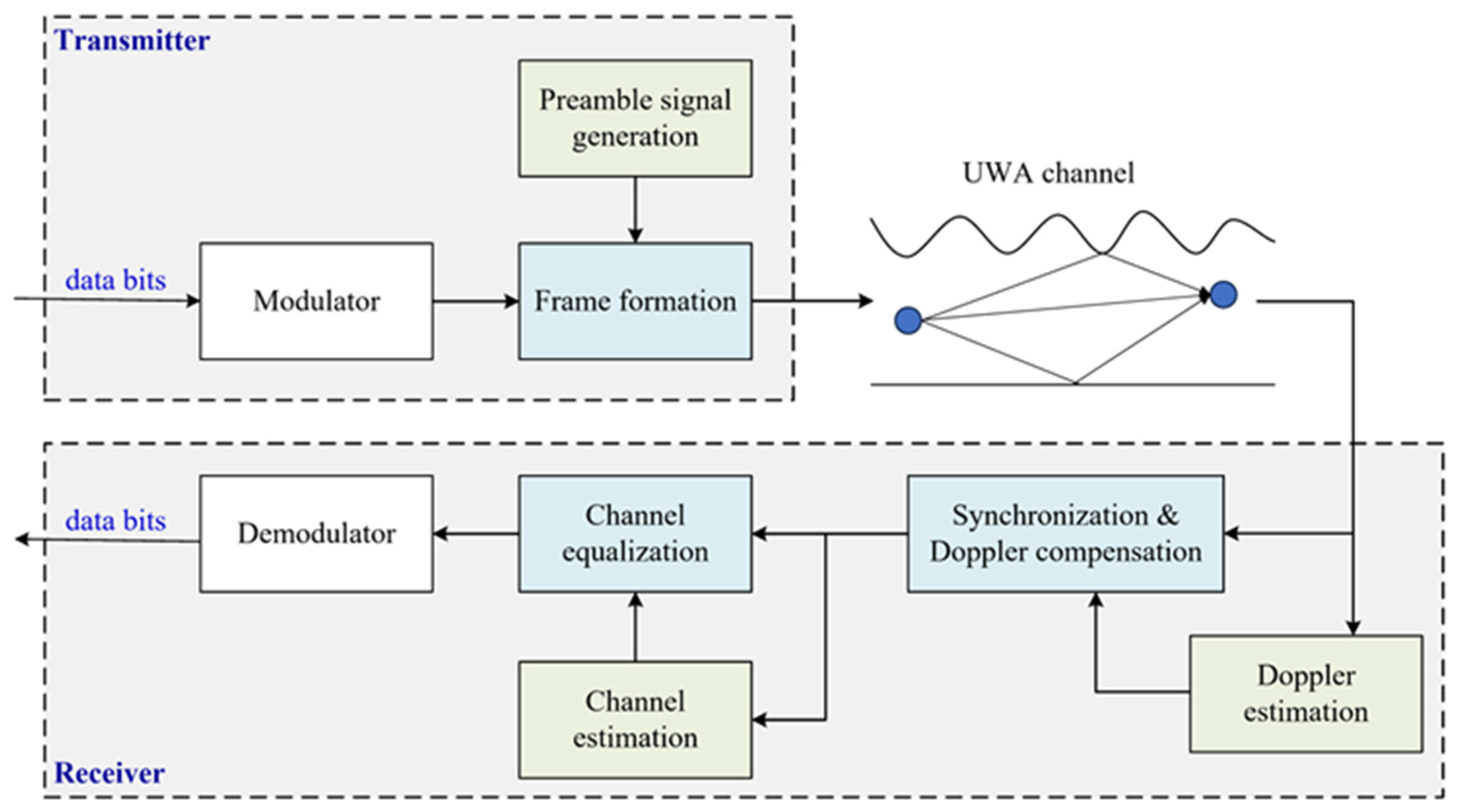
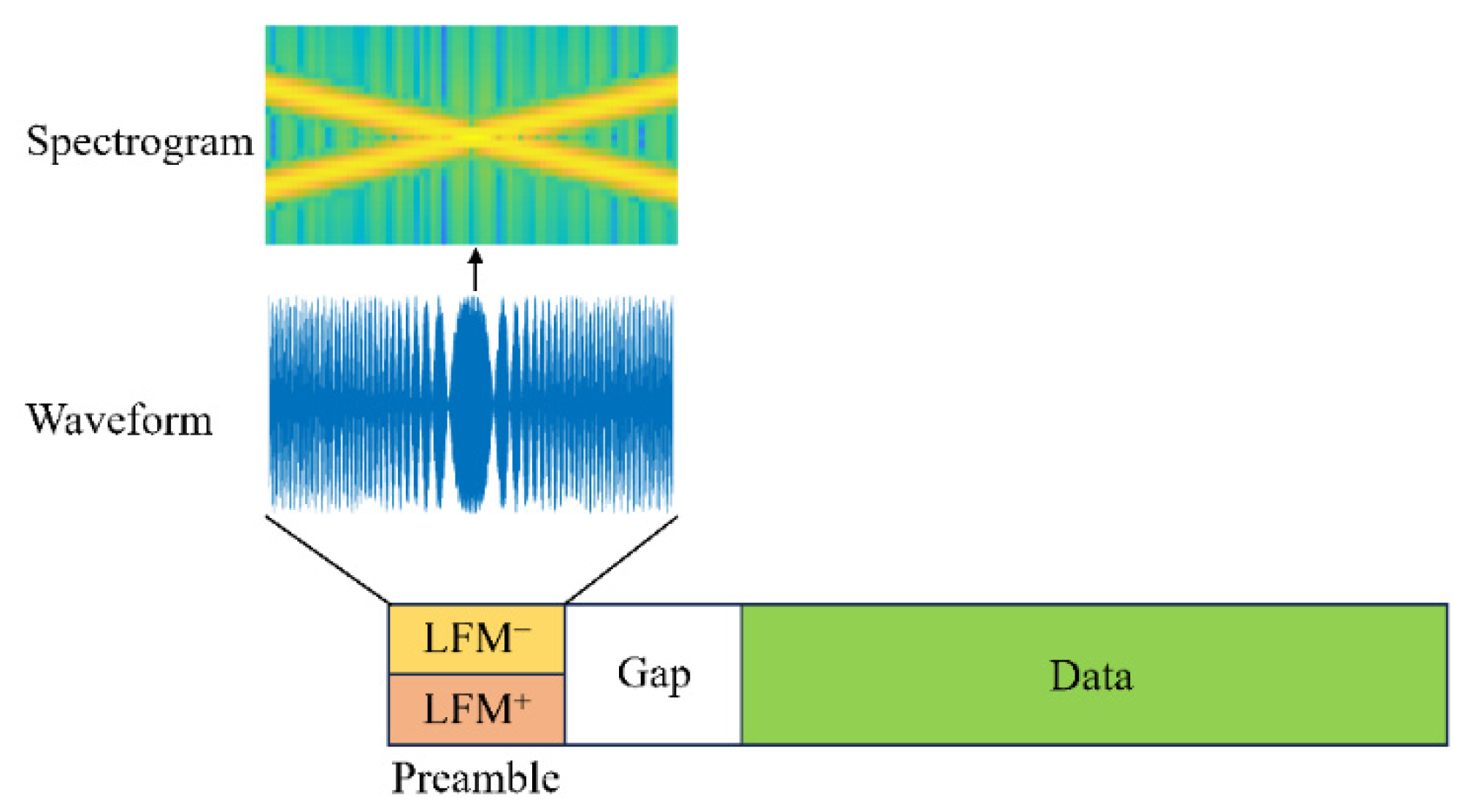
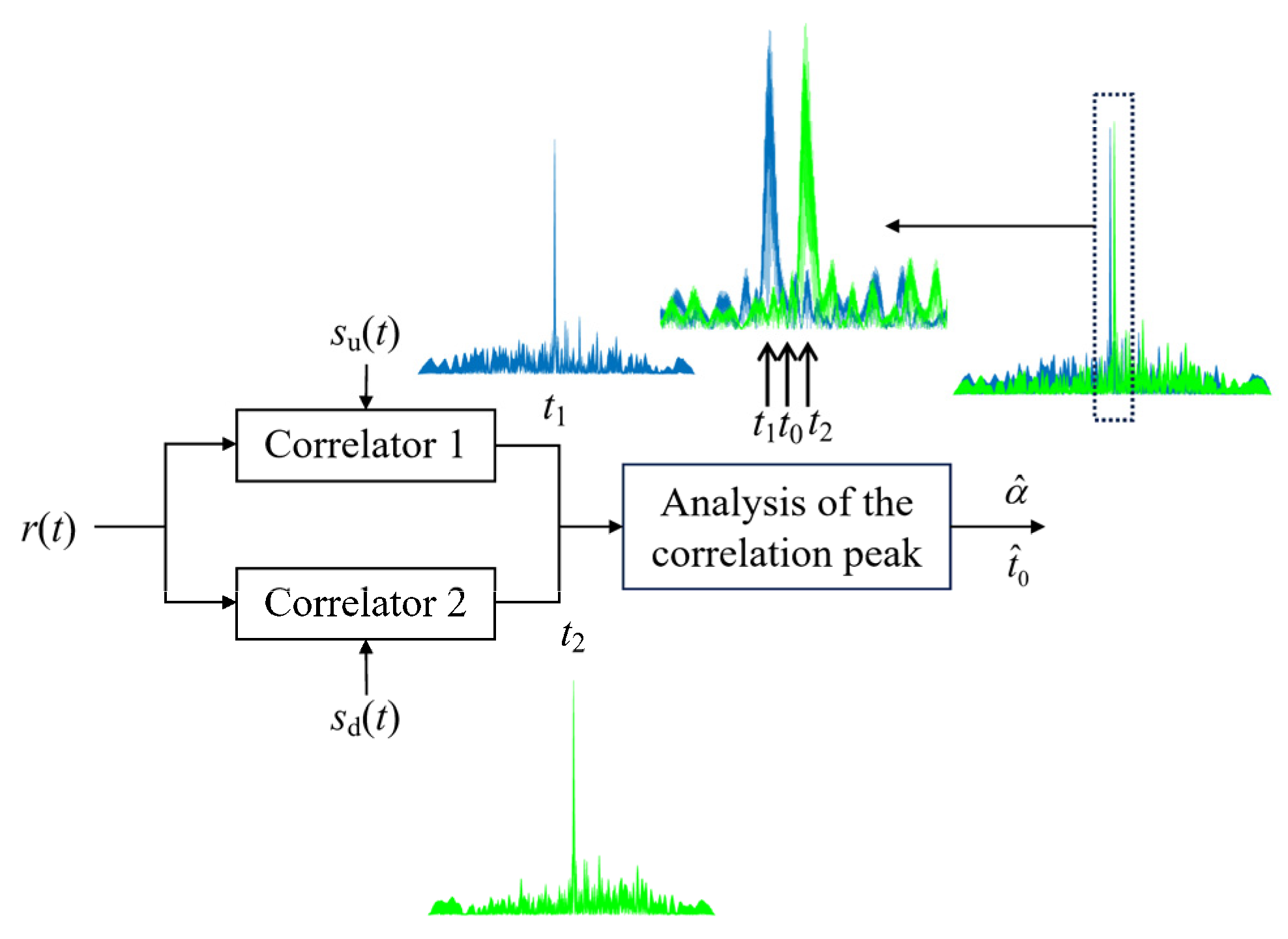

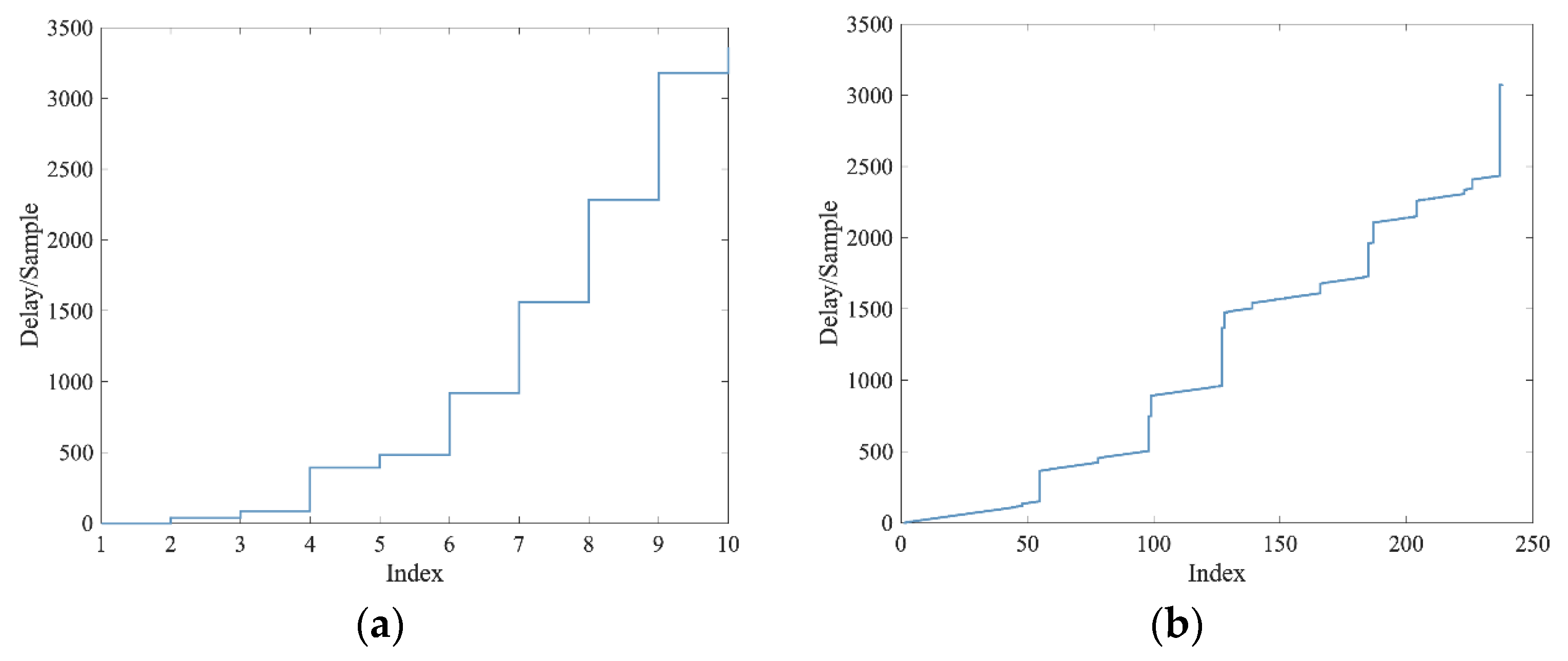
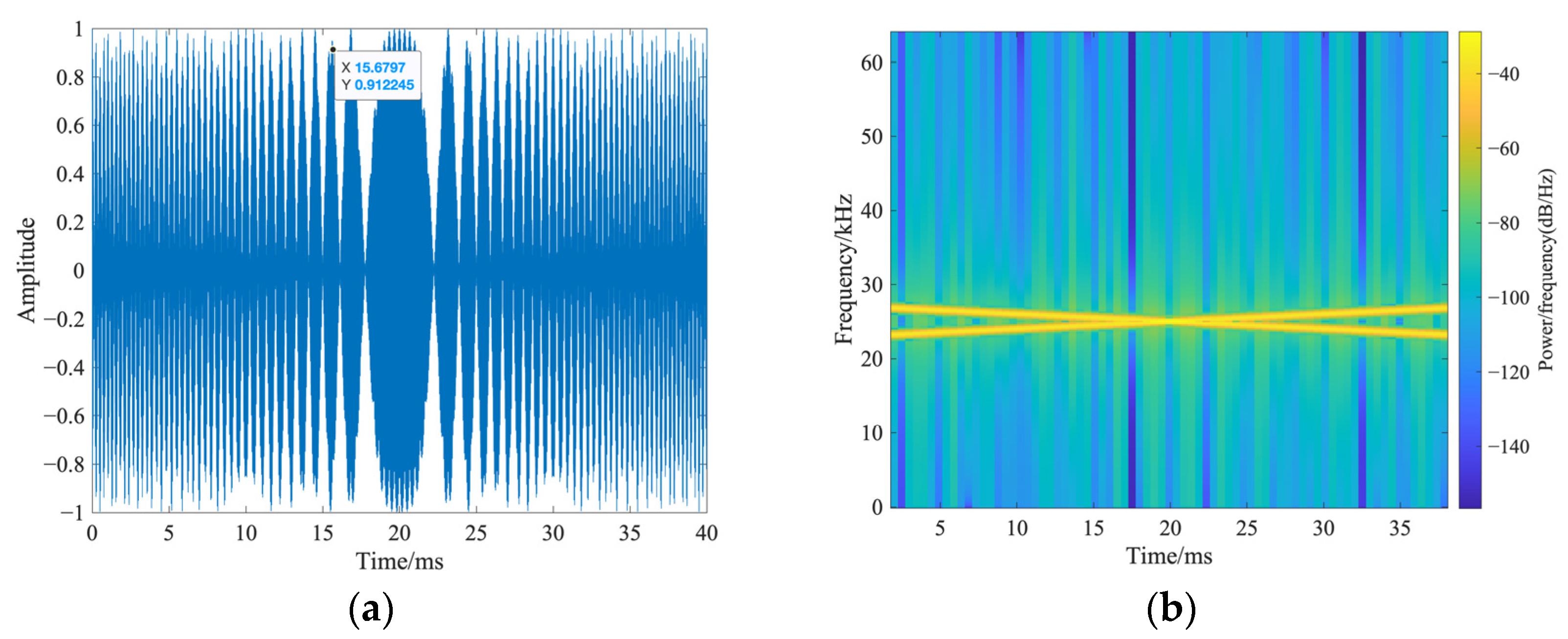
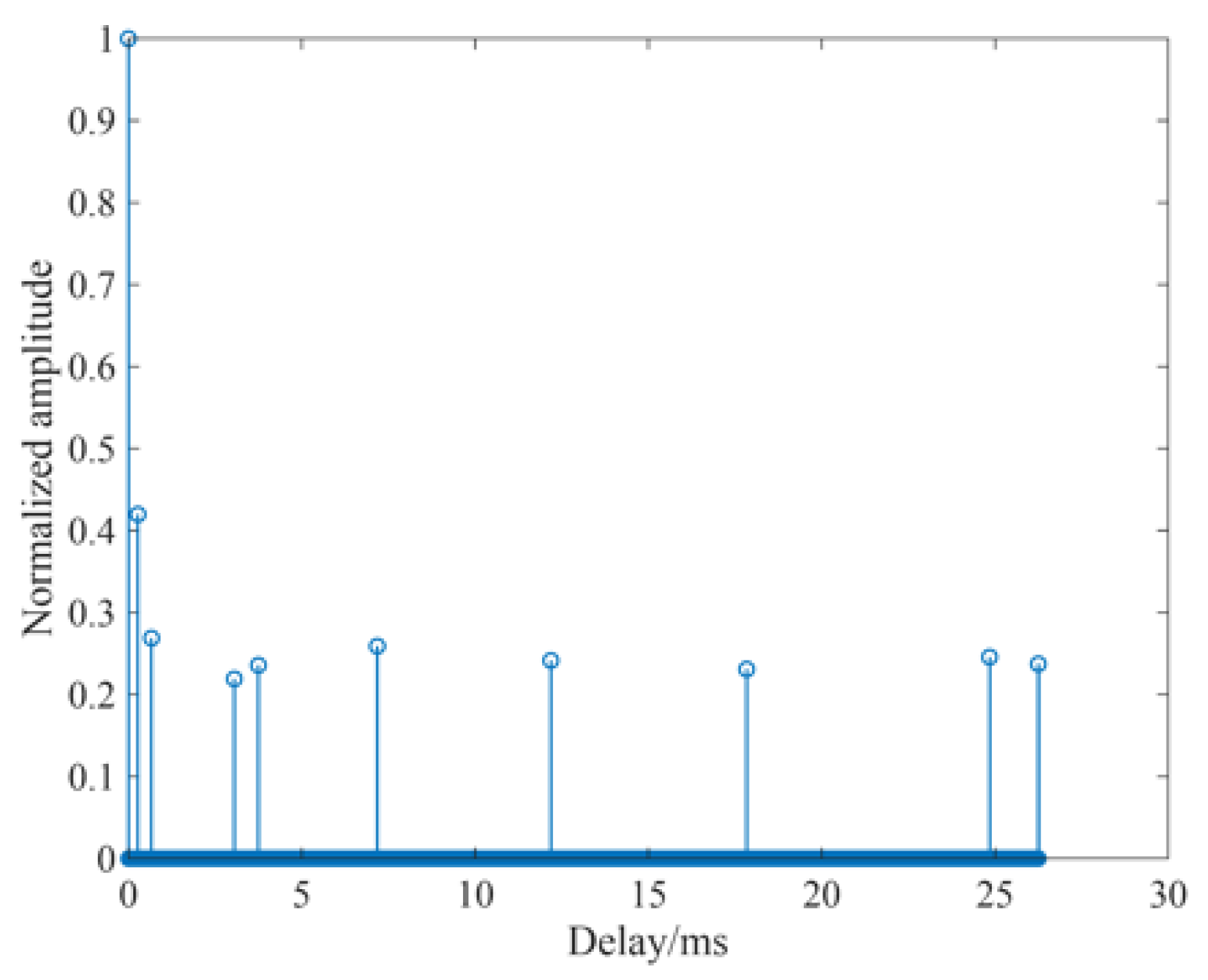
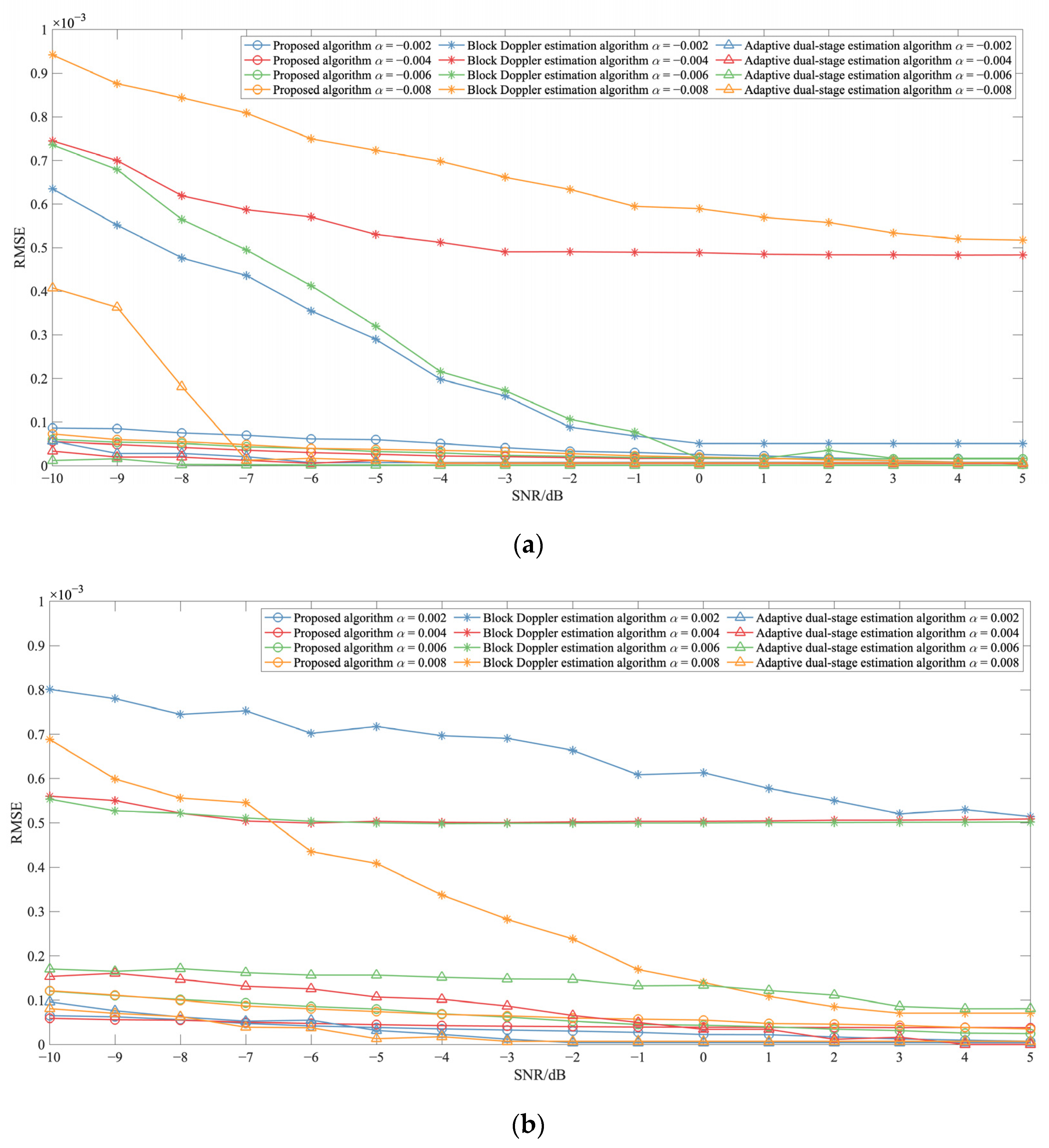

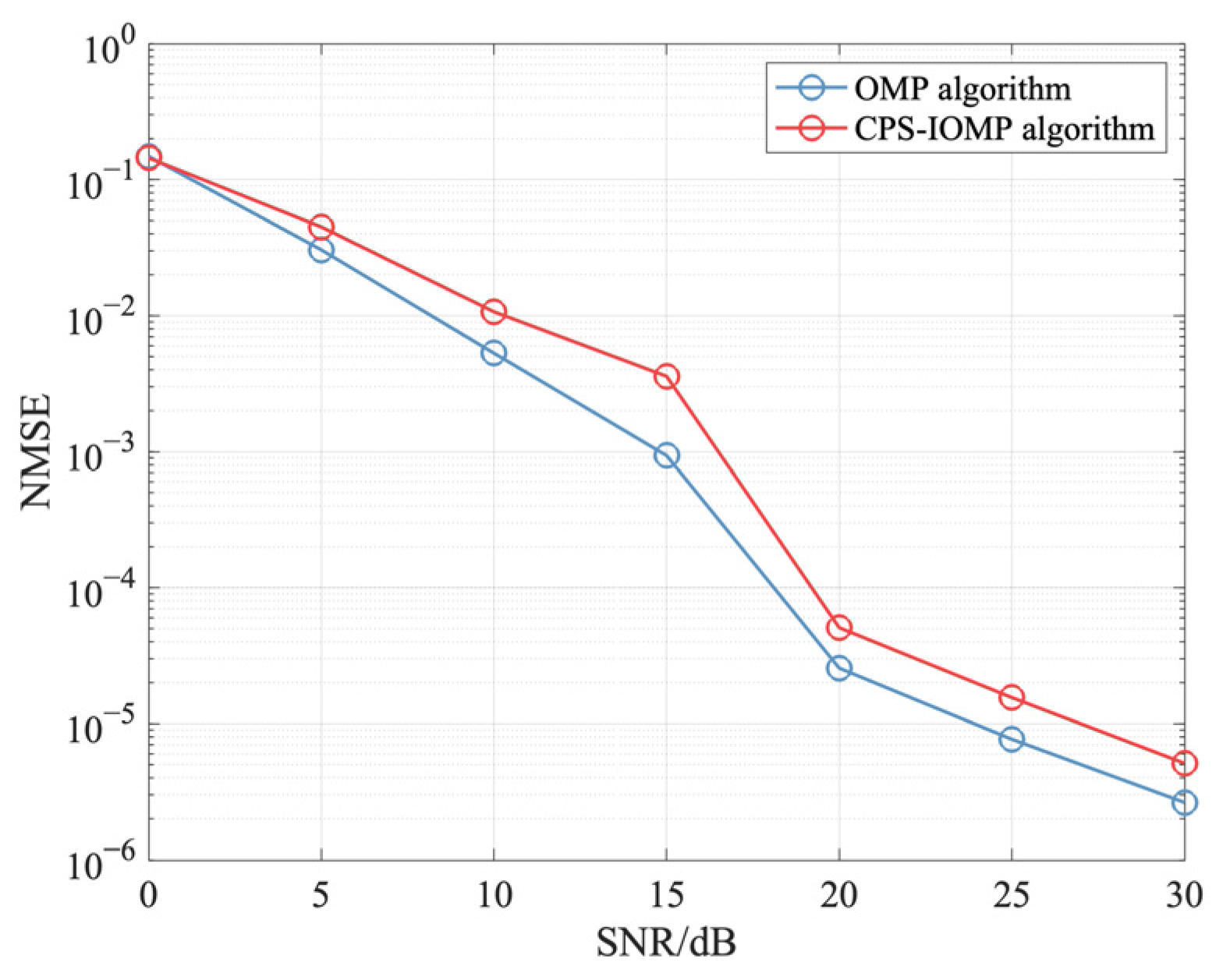

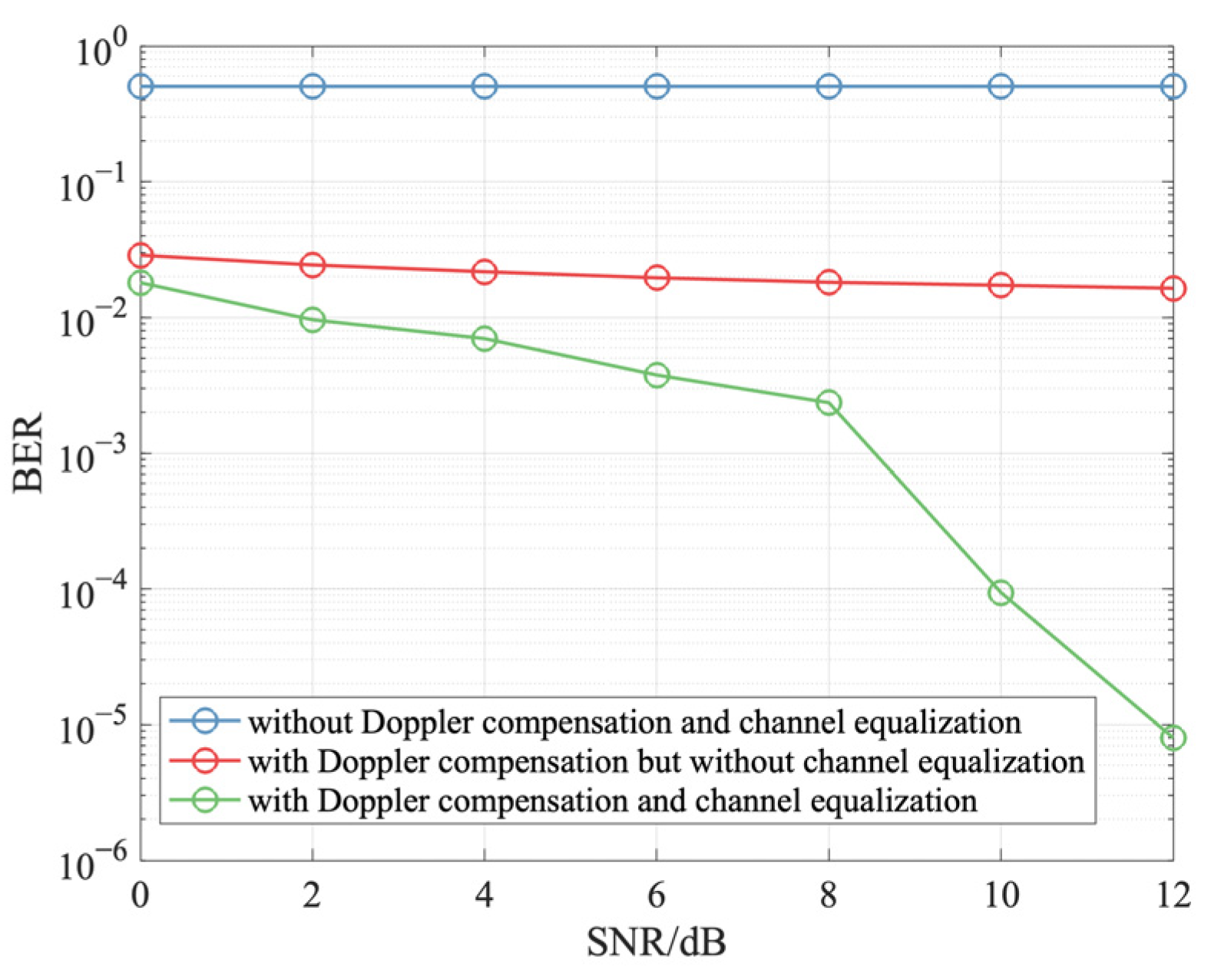

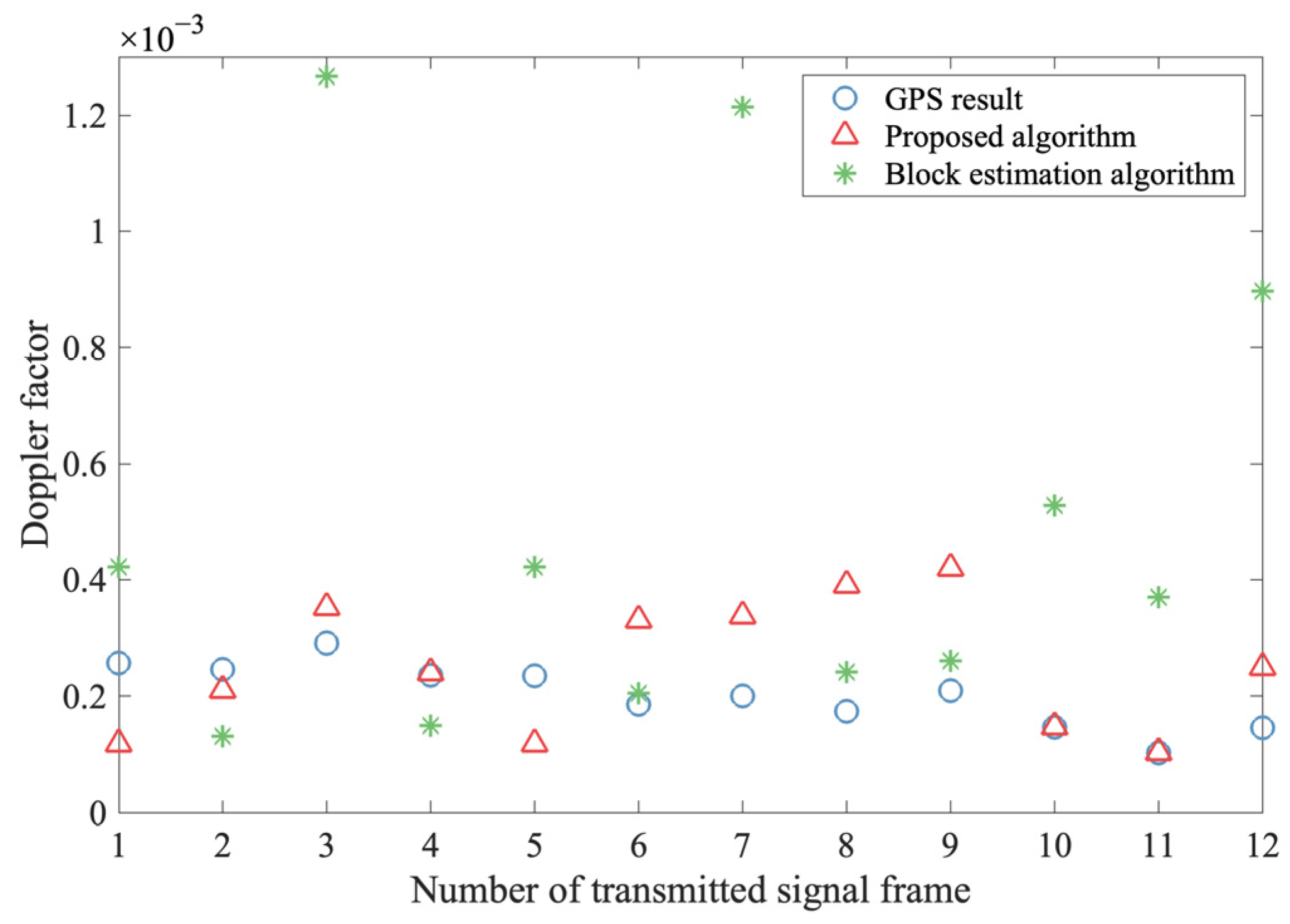
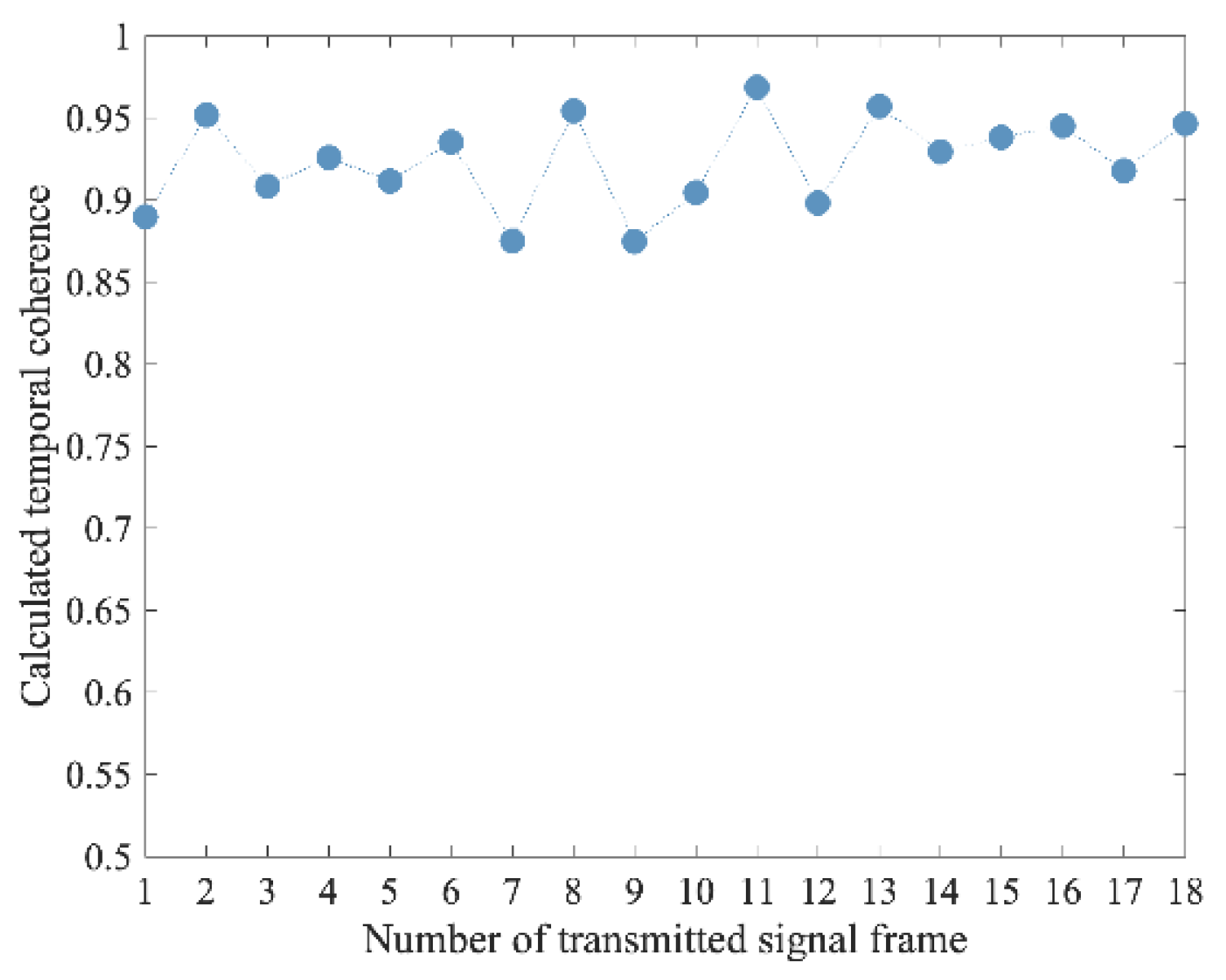
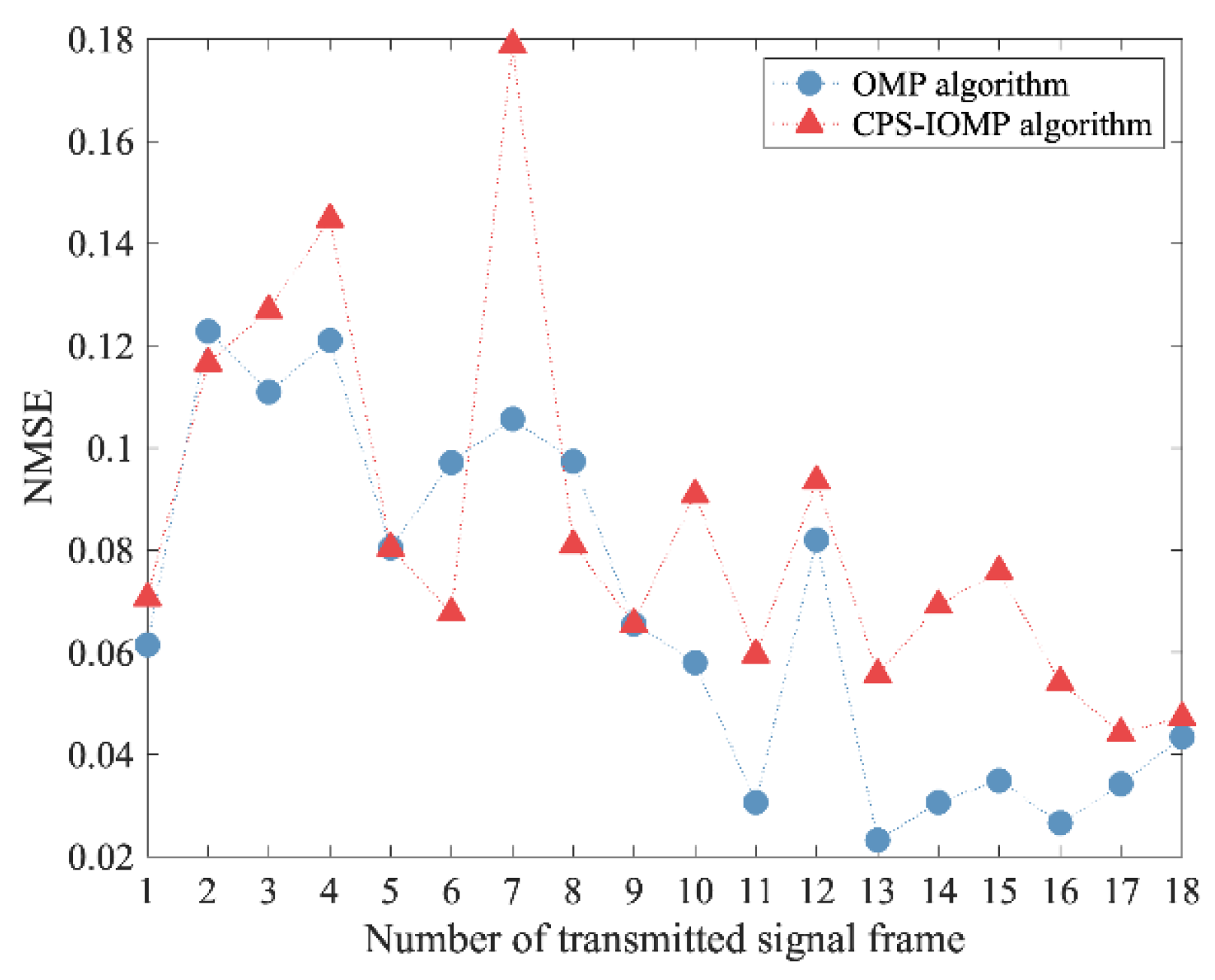
| SNR/dB | OMP Algorithm | CPS-IOMP Algorithm |
|---|---|---|
| 0 | 0.505 s | 0.261 s |
| 5 | 0.490 s | 0.282 s |
| 10 | 0.497 s | 0.273s |
| 15 | 0.488 s | 0.291 s |
| 20 | 0.491 s | 0.304 s |
| 25 | 0.490 s | 0.285 s |
| 30 | 0.489 s | 0.285 s |
| No. of Frames | OMP Algorithm | CPS-IOMP Algorithm | No. of Frames | OMP Algorithm | CPS-IOMP Algorithm |
|---|---|---|---|---|---|
| 1 | 38.445 ms | 28.315 ms | 10 | 38.427 ms | 28.021 ms |
| 2 | 38.420 ms | 33.594 ms | 11 | 38.246 ms | 26.643 ms |
| 3 | 38.646 ms | 28.743 ms | 12 | 38.444 ms | 26.578 ms |
| 4 | 38.566 ms | 27.206 ms | 13 | 38.385 ms | 27.077 ms |
| 5 | 38.417 ms | 30.495 ms | 14 | 38.570 ms | 26.110 ms |
| 6 | 38.445 ms | 35.387 ms | 15 | 38.322 ms | 26.941 ms |
| 7 | 38.402 ms | 27.462 ms | 16 | 38.180 ms | 27.964 ms |
| 8 | 38.568 ms | 33.447 ms | 17 | 38.385 ms | 28.840 ms |
| 9 | 38.358 ms | 30.266 ms | 18 | 38.691 ms | 29.185 ms |
Disclaimer/Publisher’s Note: The statements, opinions and data contained in all publications are solely those of the individual author(s) and contributor(s) and not of MDPI and/or the editor(s). MDPI and/or the editor(s) disclaim responsibility for any injury to people or property resulting from any ideas, methods, instructions or products referred to in the content. |
© 2024 by the authors. Licensee MDPI, Basel, Switzerland. This article is an open access article distributed under the terms and conditions of the Creative Commons Attribution (CC BY) license (https://creativecommons.org/licenses/by/4.0/).
Share and Cite
Lv, C.; Sun, Q.; Chen, H.; Xie, L. Doppler and Channel Estimation Using Superimposed Linear Frequency Modulation Preamble Signal for Underwater Acoustic Communication. J. Mar. Sci. Eng. 2024, 12, 338. https://doi.org/10.3390/jmse12020338
Lv C, Sun Q, Chen H, Xie L. Doppler and Channel Estimation Using Superimposed Linear Frequency Modulation Preamble Signal for Underwater Acoustic Communication. Journal of Marine Science and Engineering. 2024; 12(2):338. https://doi.org/10.3390/jmse12020338
Chicago/Turabian StyleLv, Chenglei, Qiushi Sun, Huifang Chen, and Lei Xie. 2024. "Doppler and Channel Estimation Using Superimposed Linear Frequency Modulation Preamble Signal for Underwater Acoustic Communication" Journal of Marine Science and Engineering 12, no. 2: 338. https://doi.org/10.3390/jmse12020338
APA StyleLv, C., Sun, Q., Chen, H., & Xie, L. (2024). Doppler and Channel Estimation Using Superimposed Linear Frequency Modulation Preamble Signal for Underwater Acoustic Communication. Journal of Marine Science and Engineering, 12(2), 338. https://doi.org/10.3390/jmse12020338








